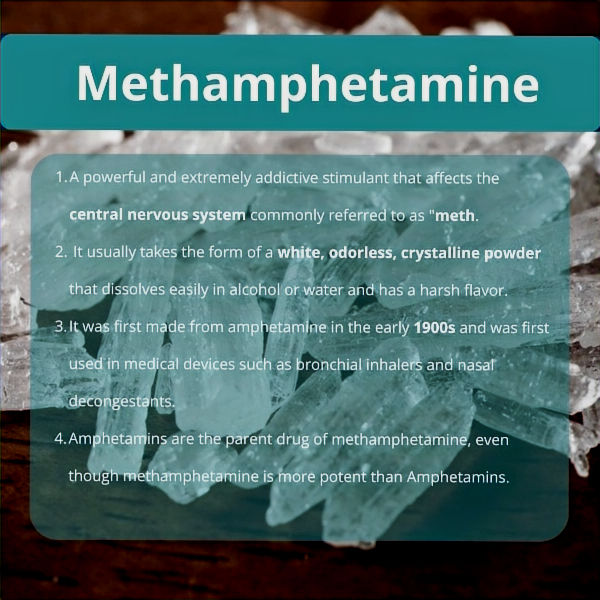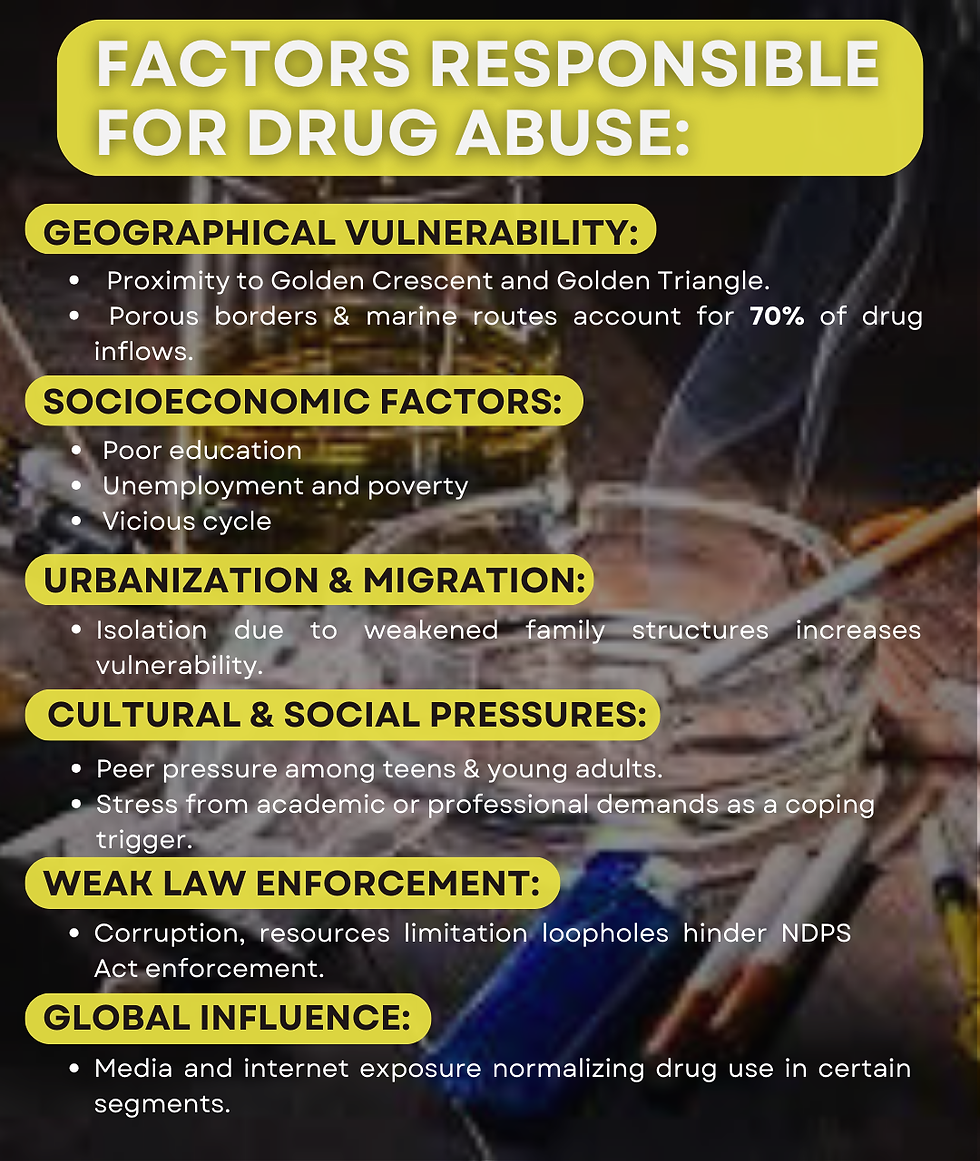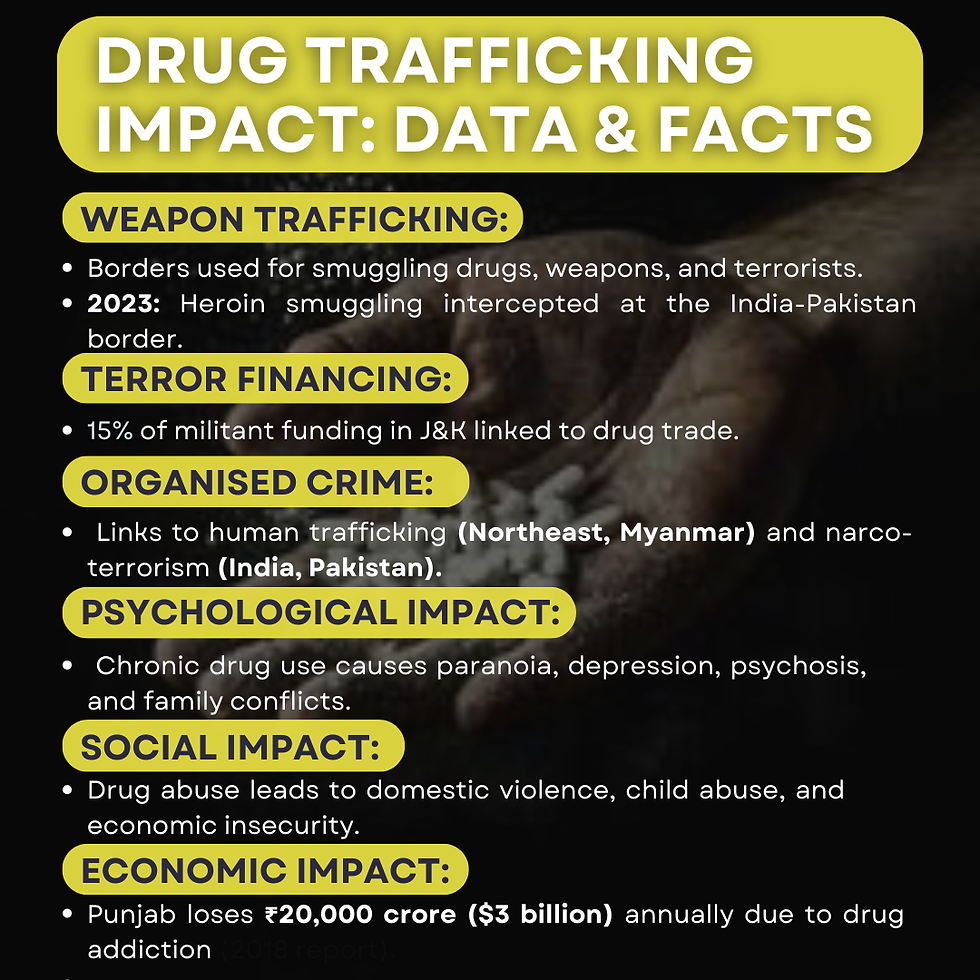Syllabus: GS 1/Society
Recent Context
India faces a growing drug abuse crisis, particularly among youth and vulnerable populations. Recently, authorities (Delhi Police) attribute this trend to the growing perception of chemical drugs as a "status symbol,particularly among the younger population. This cultural shift has contributed to the increasing prevalence and usage of such substances.
In November 2024, Indian authorities seized 6,000 kilograms of methamphetamine from a Myanmar-registered freighter in the Andaman and Nicobar Islands, marking one of the largest drug busts in recent history.

Severity of Drug Abuse in India
Drug misuse in India is a complex problem driven by a variety of causes.

Factors Responsible for Drug Abuse
Drug misuse in India is a complex problem driven by a variety of causes.
Geographical Location: India's proximity to key drug-producing regions—the Golden Crescent (Afghanistan, Iran, Pakistan) and the Golden Triangle (Myanmar, Laos, Thailand)—makes it particularly vulnerable to drug trafficking. Its porous borders and marine routes through the Arabian Sea and Bay of Bengal account for roughly 70% of illicit drug inflows into the country. Myanmar is now the world's largest opium producer.

Socioeconomic Factors:
a. Lack of Education: Poor educational quality institutions lead to disappointed ambitions, which increases the likelihood of drug use.
b. Unemployment and Poverty: Economic hardships encourage young people to use drugs as an escape from reality.
c. Perpetual cycle: Drug users from destitute households turn to drug dealing to fuel their addictions, while rising youth unemployment exacerbates their disappointment.
d. Unemployment and Poverty: Economic hardships encourage young people to use drugs as an escape from reality.
Urbanization and Migration: Rapid urbanization and weakened family structures enhance isolation, making people more vulnerable to substance abuse.
Cultural and Social Pressures: Peer pressure, particularly among teens and young adults, is a crucial factor in commencing drug use. Stress from scholastic or professional expectations might also push people to use substances as a coping method.
Weak enforcement of laws: Despite severe prohibitions under the Narcotic Drugs and Psychotropic Substances Act (NDPS), implementation remains difficult due to corruption, insufficient resources, and legal loopholes.
Easy availability: Cannabis and opium are widely available in many parts of India due to their longstanding cultivation and use. Prescription drug addiction, particularly of opioids and sedatives, is on the rise due to lax rules and simple online access.
Global Influence: Exposure to global lifestyles via media and the internet has resulted in changes in social standards, making drug use more acceptable in certain segments of society.
Government Initiatives to Tackle Drug Abuse
Key Legislations: The Drugs and Cosmetics Act of 1940, the Narcotic Drugs and Psychotropic Substances Act of 1985, and the Prevention of Illicit Traffic in Narcotic Drugs Act of 1988 are important pieces of legislation that limit drug use in India.
NCB: The Narcotics Control Bureau (NCB), which was founded in 1986, is the main organization in charge of coordinating activities across the country to enforce drug prohibitions in India.
Nasha Mukt Bharat Abhiyan: Launched on 15th August 2020, the goal of the Nasha Mukt Bharat Abhiyan is to decrease substance misuse by raising awareness through education and community engagement.
National Action Plan for Drug Demand Reduction (NAPDDR): Through education, de-addiction, and rehabilitation, the National Action Plan for Drug Demand Reduction (NAPDDR) sought to lower the demand for illegal substances.
Ratified Conventions: The United Nations Convention on Narcotic Drugs (1961), the United Nations Convention on Psychotropic Substances (1971), and the United Nations Convention against Illicit Traffic in Narcotic Drugs (1988) are among the important international accords that India has ratified.

Impact of Drug Abuse
Health Consequences: Over 15 million children aged 10 to 17 are battling substance addiction.Intravenous drug use accounts for 6% of all HIV cases and raises the risk of hepatitis B and C.
Economic Burden: Drug addiction costs India around ₹1.44 lakh crore yearly, which includes healthcare costs, productivity loss, and crime management. Addiction also puts a drain on families' emotional and financial resources.
Impact on Youth: The Ministry of Social Justice and Empowerment reports that more than 46% of drug users in India are between the ages of 18 and 30. Punjab is one of the worst-affected states, with one in every three households reporting drug usage.
Increase in Crime: Drug misuse increases the risk of domestic violence, theft, and other crimes.
Regional Impact: Northeast India is especially vulnerable because of its proximity to the "Golden Triangle.". Punjab and Haryana have high rates of drug trafficking and addiction, with opioids being the most often consumed substance.
Limitations of Government Policies: 'Nasha Mukt Bharat Abhiyaan' and other programs are designed to fight drug usage; however, issues including stigma and a shortage of rehabilitation facilities still exist. Only 1 in 38 people who need intervention receive proper care (AIIMS report 2019).
Challenges of Drug Abuse
Weapon Trafficking: Drug traffickers use international borders not only to transport narcotics but also to sneak weapons and terrorists into the country, increasing security issues. In 2023, the Directorate of Revenue Intelligence (DRI) apprehended heroin smuggling activity along the India-Pakistan border.
Terror Financing: The illegal drug trade generates significant income, which is frequently diverted to terrorist activities, fueling extremism and instability. In Jammu and Kashmir, roughly 15% of militant funding comes from drug trafficking/smuggling.
Aiding organized crime: Drug trafficking serves as a gateway for other forms of organized crime, such as human trafficking (Northeast India and Myanmar) and narco-terrorism (India and Pakistan), because these criminal activities share channels and networks.
Psychological Consequences: Drug addiction not only disrupts individuals' financial well-being but also causes emotional instability within families, resulting in psychological discomfort and conflict. Chronic substance abuse, such as methamphetamine or cocaine, can result in paranoia, depression, and psychosis, straining relationships and causing tension in families.
Adverse Social Impact: Drug addiction destabilizes families, straining relationships and resulting in difficulties like domestic violence, child abuse, economic insecurity, and limited access to education.
Economic Impact: Drug usage imposes a significant economic impact, resulting in productivity losses and diverting resources for addict rehabilitation and treatment. According to a 2018 Punjab State Government's report, the state's drug addiction crisis costs the economy approximately ₹20,000 crore ($3 billion) per year in lost productivity.
Undermining State Institutions: The trafficking network has the potential to corrupt state agencies and institutions, jeopardizing governance and threatening political stability.
Way Forward to Combat the Menace of Drug Abuse in India
Strategies for Reducing Demand: To deter drug use, awareness campaigns, community-based prevention initiatives, and educational initiatives in schools should be put in place. For example, the "Nasha Mukt Bharat" effort to educate adolescents about the hazards of drug abuse.
Vigilant Tracking on Drug Supply Networks: Vigilantly monitoring and tracking suppliers and manufacturers not only by solely focusing on the peddlers. For example, Operation "Black Cobra" targeted Golden Crescent drug hubs (Afghanistan, Iran, and Pakistan).
Coordinated intelligence: Create mechanisms for agencies to exchange information in order to efficiently monitor drug supply chains. For example, in November 2024, NCB's Operation Sagar Manthan used intelligence sharing to break up global drug syndicate 'Lord of Drugs'.
Coordination with civil society and NG's: Through NGOs and neighborhood associations, civil society can assist with counseling, awareness campaigns, and rehabilitation. For example, non-governmental organizations such as "TARANG" focus on drug misuse awareness and rehabilitation.
The International Day Against Drug Abuse, observed on June 26, highlights global efforts to combat drug abuse. This year's theme, "The evidence is clear: invest in prevention," emphasizes the importance of proactive measures to build a drug-free world.
Conclusion
Illicit drug trafficking harms individuals and society, threatening an entire generation. It is the shared responsibility of all sectors to support enforcement agencies in combating this menace.Addressing drug abuse requires a comprehensive strategy involving prevention, education, treatment, harm reduction, policy reforms, and community engagement. Collaboration among government agencies, healthcare providers, NGOs, and communities is essential to mitigating its impact in India.
UPSC Mains Model Question
Q. India is witnessing a growing drug abuse crisis, particularly among its youth and vulnerable populations, fueled by the perception of chemical drugs as a status symbol. Discuss the sociocultural, economic, and policy-related factors contributing to this issue. Suggest effective measures to address the problem comprehensively.(250 words)
References


Balanced write up and informative for UPSC aspirants…
Your article is a powerful contribution to raising awareness about the challenges of drug abuse and its impact on individuals and communities. By shedding light on this critical issue, you’re fostering understanding, empathy, and action. Keep using your voice to inspire positive change—your work has the potential to make a real difference!"
Great job raising awareness about this important issue. Your article is informative and thought-provoking.
After reading this it will help me a lot in GS 1, we need more such posts .
Drug abuse is a significant topic for general knowledge and competitive exams like UPSC. particularly in GS1 and Ethics. The information provided here is carefully crafted with precise facts and up-to-date data. making it highly relevant and valuable to the UPSC mains. It offers a reliable resource for students to deepen their academic knowledge and excel in competitive exams. For UPSC/IAS aspirants and those looking to enhance their general awareness and knowledge, this serves as an excellent platform.
Hats off to the writer ma'am.